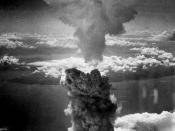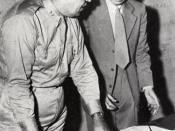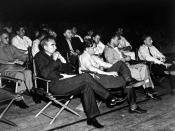Atomic Bomb: Fission vs. Fusion
Just before the beginning of World War II, Albert Einstein wrote a letter to President Franklin D. Roosevelt. Urged by Hungarian-born physicists Leo Szilard, Eugene Wingner, and Edward Teller, Einstein told Roosevelt about Nazi German efforts to purify Uranium-235 which might be used to build an atomic bomb. Shortly after that the United States Government began work on the Manhattan Project. The Manhattan Project was the code name for the United States effort to develop the atomic bomb before the Germans did. "The first successful experiments in splitting a uranium atom had been carried out in the autumn of 1938 at the Kaiser Wilhelm Institute in Berlin" just after Einstein wrote his letter. So the race was on. Major General Wilhelm D. Styer called the Manhattan Project "the most important job in the war . . . an all-out effort to build an atomic bomb."(Groueff
5) It turned out to be the biggest development in warfare and science's biggest development this century. The most complicated issue to be addressed by the scientists working on the Manhattan Project was "the production of ample amounts of 'enriched' uranium to sustain a chain reaction."(Outlaw 2) At the time, Uranium-235 was hard to extract. Of the Uranium ore mined, only about 1/500 th of it ended up as Uranium metal. Of the Uranium metal, "the fissionable isotope of Uranium (Uranium- 235) is relatively rare, occurring in Uranium at a ratio of 1 to 139."(Szasz 15) Separating the one part Uranium-235 from the 139 parts Uranium-238 proved to be a challenge. "No ordinary chemical extraction could separate the two isotopes. Only mechanical methods could effectively separate U-235 from U-238."(2) Scientists at Columbia University solved this difficult problem. A "massive enrichment laboratory/plant"(Outlaw 2) was built at Oak Ridge, Tennessee. H.



Excellent
Explains fission and fusion with very good examples.
0 out of 0 people found this comment useful.